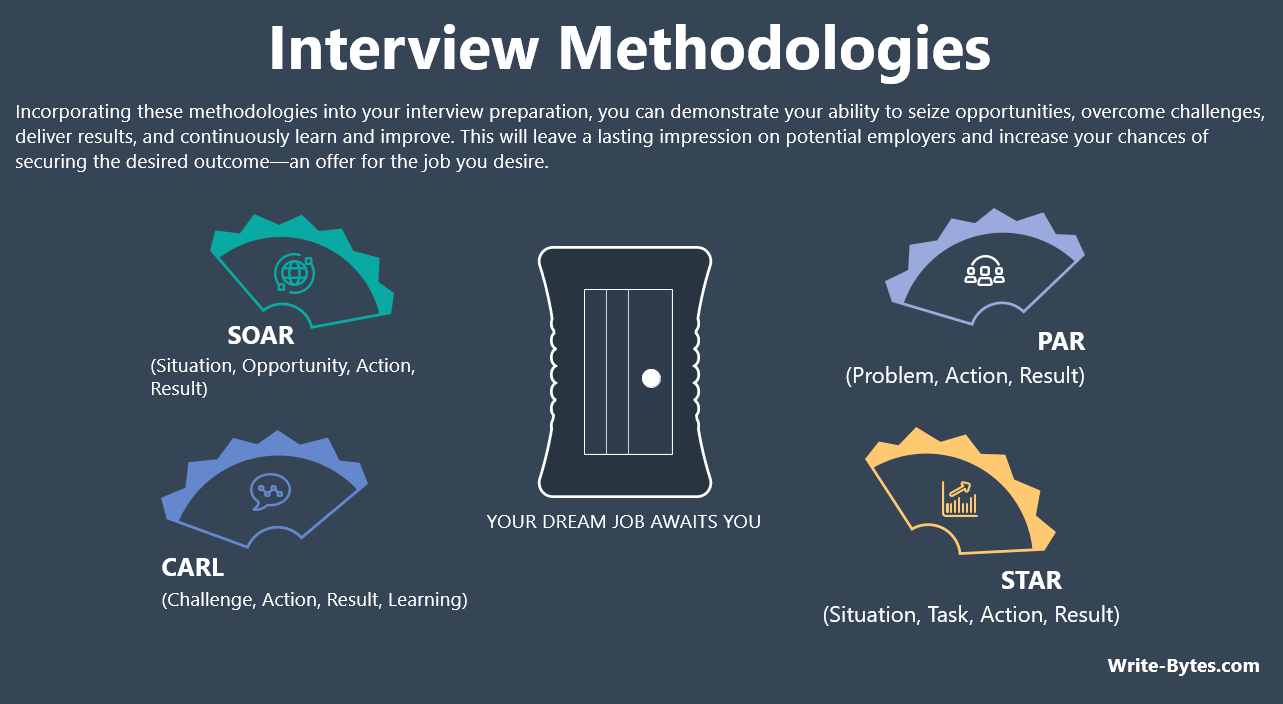Introduction:
In today’s competitive job market, standing out during an interview requires more than just a polished resume. Effective communication and structured responses play a vital role in showcasing your skills and experiences. One way to achieve this is by utilizing specific methodologies to answer interview questions. In this blog post, we will delve into 5 Effective Interview Techniques SOAR, PARI, CARL, PAR, and STAR. By understanding the significance of each methodology and knowing when and where to apply them, you can maximize your chances of getting the desired results and impress potential employers.
SOAR (Situation, Opportunity, Action, Result)
The SOAR methodology provides a framework for identifying opportunities within a given situation and taking decisive action to achieve positive results. It encourages candidates to think proactively and highlight their ability to seize opportunities and make a meaningful impact. This methodology is particularly useful in competency-based interviews where the focus is on achievements, problem-solving skills, and demonstrating a forward-thinking mindset.
When applying the SOAR methodology, start by describing the specific situation or context you encountered. Then, identify the opportunities that arose from that situation. Next, explain the actions you took to capitalize on those opportunities and bring about positive outcomes. Finally, discuss the results achieved and the impact they had on the organization or project.
PARI (Problem, Action, Result, Improvement)
PARI is a method that emphasizes continuous improvement and learning from past experiences. It allows candidates to demonstrate their ability to overcome challenges and grow both personally and professionally. When using the PARI methodology, it’s important to acknowledge the specific problems or obstacles you faced. Then, outline the actions you took to address those challenges and achieve successful outcomes. Next, highlight the results achieved and quantify them whenever possible. Lastly, emphasize how you identified areas for improvement and implemented changes based on the lessons learned.
The PARI methodology is particularly effective when answering questions about overcoming obstacles, managing difficult situations, or delivering successful outcomes while showcasing adaptability, resilience, and a growth mindset.
CARL (Challenge, Action, Result, Learning)
Similar to the PARI method, CARL places a strong emphasis on personal growth and learning. It allows candidates to showcase their ability to turn challenges into valuable learning opportunities. When utilizing the CARL methodology, start by describing the specific challenges or difficulties you faced. Then, explain the actions you took to overcome those challenges, highlighting your problem-solving skills and determination. Next, discuss the results achieved and quantify them to illustrate your impact. Lastly, reflect on the lessons learned from the experience and how they have contributed to your personal and professional development.
The CARL methodology is particularly effective when sharing experiences that involved significant challenges and demonstrating your ability to learn from setbacks and apply those insights to future situations.
PAR (Problem, Action, Result)
The PAR method provides a structured approach to answering interview questions by clearly defining a problem, explaining the actions taken to address it, and highlighting the positive outcomes and results achieved. This methodology is highly effective in showcasing your problem-solving skills, decision-making abilities, and track record of delivering tangible results.
To apply the PAR methodology, start by clearly defining the problem or challenge you encountered. Provide relevant details and context to help the interviewer understand the situation. Then, explain the specific actions you took to address the problem, highlighting your thought process and strategic approach. Next, discuss the results you achieved and quantify them whenever possible to demonstrate the impact of your actions. Finally, conclude by summarizing the key takeaways and lessons learned from the experience.
STAR (Situation, Task, Action, Result)
The STAR methodology is widely recognized and used for answering behavioral interview questions. It provides a structured approach to describing situations, tasks, actions, and results, allowing you to effectively showcase your skills, experiences, and achievements. The STAR method is applicable to various types of interview questions, especially those seeking specific examples of your competencies.
When using the STAR methodology, start by describing the Situation or context in which the experience occurred. Provide background information and set the stage for the interviewer. Then, explain the Task or objective you were assigned or the goal you needed to accomplish. Be clear and concise in outlining the specific responsibilities and expectations.
Next, detail the Actions you took to address the situation or task at hand. Focus on your personal contributions and the steps you took to achieve the desired outcome. Be sure to highlight any challenges or obstacles you encountered and how you navigated through them.
Finally, discuss the Results you achieved as a result of your actions. Quantify the outcomes whenever possible to provide concrete evidence of your accomplishments. Highlight the positive impact you had on the project, team, or organization. Additionally, emphasize any recognition or accolades received as a result of your contributions.
The STAR method allows you to provide a comprehensive and organized response, making it easier for the interviewer to assess your suitability for the role. It also demonstrates your ability to effectively communicate and articulate your experiences.
Conclusion
Utilizing structured methodologies like SOAR, PARI, CARL, PAR, and STAR can significantly enhance your interview performance and increase your chances of success. Each methodology offers a unique framework for organizing and presenting your experiences, skills, and achievements. By understanding the significance of each methodology and tailoring your responses accordingly, you can effectively communicate your abilities and stand out as a strong candidate.
Remember to adapt these methodologies to your own experiences and provide specific examples that showcase your strengths and problem-solving capabilities. Practice and preparation are key to mastering these techniques and confidently navigating interviews. By incorporating these methodologies into your interview preparation, you can demonstrate your ability to seize opportunities, overcome challenges, deliver results, and continuously learn and improve. This will leave a lasting impression on potential employers and increase your chances of securing the desired outcome—an offer for the job you desire.
